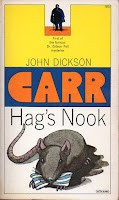First for the Golden Cover Scavenger Hunt. For this, I have read 15 books. I did seem to be quite attracted to the covers of books by John Dickson Carr. I have six covers of his books in my list.
1. Hag's Nook by John Dickson Carr. 1933. Picture of any other animal (rat)
2. The Lost Gallows by John Dickson Carr. 1931. Picture of a hangman's noose.
3. The Santa Klaus Murder by Mavis Doriel Hay. 1936. Picture of a Christmas tree.
4. Speak No Evil by Mignon G. Eberhart. 1940. Picture of a telephone.
5. The Deadly Truth by Helen McCloy. 1946. Picture of a drinking glass.
6. Artists in Crime by Ngaio Marsh. 1938. Picture of Artist/Art Equipment.
7. The Skeleton in the Clock by John Dickson Carr. 1948. Picture of a clock/timepiece.
8. The Estate of the Beckoning Lady by Marjorie Allingham. 1955. Picture of a policeman.
9. No Coffin for the Corpse by Clayton Rawson. 1942. Picture of just one person.
10. And So to Murder by Carter Dickson. 1940. Picture of a typewriter.
11. The Reader is Warned by Carter Dickson. 1939. Picture of a mask.
12. Watson's Choice by Gladys Mitchell. 1955. Picture of a skull.
13. Love Lies Bleeding by Edmund Crispin. 1948. Picture of a revolver.
14. The Emperor's Snuff Box by John Dickson Carr. 1942. Picture of a broken object.
15. The Fallen Sparrow by Dorothy B. Hughes. 1943. Picture of a bird.
Then I attempted the Silver Cover Scavenger Hunt. For this I read ten books. I did rather get carried away by the books of Emma Lathen, and read five books by her (actually, by them). I do think that John Putnam Thatcher is a very likeable detective.
1. Sweet Death, Kind Death by Amanda Cross. 1984. Picture of a body of water.
2. No Case for the Police by V. C. Clinton-Baddeley. 1970. Picture of a clock.
3. Death's Bright Dart by V. C. Clinton-Baddeley. 1967. Picture of a blue object.
4. A Stitch in Time by Emma Lathen. 1968. Picture of a nurse.
5. Murder Against the Grain by Emma Lathen. 1967. Picture of two people.
6. Death of a Mystery Writer by Robert Barnard. 1978. Picture of a drinking glass.
7. The Bay Psalm Book Murder by Will Harriss. 1983. Picture of a skeletal hand.
8. Banking on Death by Emma Lathen. 1961. Picture of a dead body.
9. The Longer the Thread by Emma Lathen. 1971. Picture of just one person.
10. Green Grow the Dollars by Emma Lathen. 1982. Picture of a green object.
































